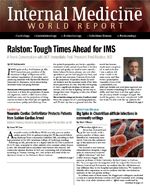Publication
Article
Internal Medicine World Report
ARDS Has Lingering Negative Impact
ARDS Has Lingering Negative Impact
New research shows that functional disability continues 5 years after acute respiratory distress syndrome
By Kurt Ullman
Most studies related to functional or pulmonary outcomes following acute respiratory distress syndrome (ARDS) have been limited to 2 years of follow-up. New research from Canada finds many on-going problems in these patients as much as 5 years from the onset of ARDS.
“Very little work has been done on longer-term outcomes, costs and healthcare issues in those who survive severe critical illness,” said lead author Margaret Herridge, MD, from the Department of Medicine at the University of Toronto. “Many lay people and even healthcare providers have assumed that these people either die or get completely better.”
Herridge’s research team evaluated 109 survivors of ARDS at 3, 6, and 12 months, and then yearly up to 5 years from discharge from the Intensive Care Unit (ICU). The participants were interviewed and examined, underwent a battery of pulmonary function tests, the 6-minute walk test, resting and exercise oximetry, chest imaging, and a quality-of-life evaluation. They also were asked about their use of health care services.
At 5 years, the median 6-minute walk distance was 436 meters (76% of expected), and the Physical Component Score on the Medical Outcomes Study 36-Question Short Form Health Survey was 41 (mean score matched for age and sex was 50). The researchers found that the younger the patient, the greater the rate of recovery. However, most patients regardless of age had not returned to normal predicted levels of functioning even after 5 years.
“Even in this group of relatively young patients (median age 45), with few pre-existing health problems who were working full time before their severe critical illness/ARDS, few regained normal exercise ability, quality of life and had increased healthcare utilization and costs to 5-years after ICU discharge,” Herridge noted. “Also, both patients and family caregivers had important challenges with depression, anxiety, and post traumatic stress disorder during this same period.”
Before their illness, 83% of the subjects were working full time. By the final year of follow-up, 77% had returned to work. Fifty-one percent reported at least one episode of physician-diagnosed depression, and several had what the researchers called “substantial mental health challenges.” Patients had at least near-normal volumetric and spirometric tests by the last year of the study. Most of the deaths in the group (12) happened during the first year, with an additional 9 patients who died over the next 4 years.
“As critical care physicians, we would have assumed that these previously healthy patients were the ones who would have the best outcomes. Yet, they have, on average, some degree of persistent disability,” said Dr. Herridge. “I think it’s important to be aware of the (likely irreversible) functional disability and the many other health issues that may plague patients in the longer-term. Patients will need care for these health concerns, which may become chronic health problems.”
The research was supported by grants from the Canadian Intensive Care Foundation, the Physician’s Services Incorporated Foundation, and the Ontario Thoracic Society. The authors reported no relevant conflicts of interest.
Source: Herridge MS, et al. Functional disability 5 years after acute respiratory distress syndrome. N Engl J Med. 2011;364:1293-1304.
